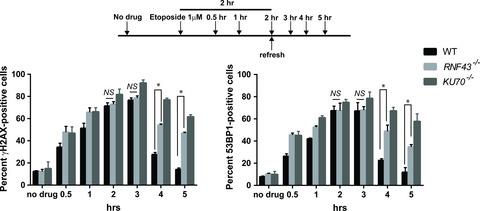当前位置:
X-MOL 学术
›
Genes Cells
›
论文详情
Our official English website, www.x-mol.net, welcomes your feedback! (Note: you will need to create a separate account there.)
A DNA repair player, ring-finger protein 43, relieves etoposide-induced topoisomerase II poisoning.
Genes to Cells ( IF 2.1 ) Pub Date : 2020-09-16 , DOI: 10.1111/gtc.12808 Tassanee Lerksuthirat 1 , Rakkreat Wikiniyadhanee 2 , Wasana Stitchantrakul 1 , Sermsiri Chitphuk 1 , Nauljun Stansook 3 , Nut Pipatpanyanugoon 4 , Siwanon Jirawatnotai 4 , Donniphat Dejsuphong 2
Genes to Cells ( IF 2.1 ) Pub Date : 2020-09-16 , DOI: 10.1111/gtc.12808 Tassanee Lerksuthirat 1 , Rakkreat Wikiniyadhanee 2 , Wasana Stitchantrakul 1 , Sermsiri Chitphuk 1 , Nauljun Stansook 3 , Nut Pipatpanyanugoon 4 , Siwanon Jirawatnotai 4 , Donniphat Dejsuphong 2
Affiliation

|
Ring finger protein 43 (RNF43) is an E3 ubiquitin ligase which is well‐known for its role in negative regulation of the Wnt‐signaling pathway. However, the function in DNA double‐strand break repairs has not been investigated. In this study, we used a lymphoblast cell line, DT40, and mouse embryonic fibroblast as cellular models to study DNA double‐strand break (DSB) repairs. For this purpose, we created RNF43 knockout, RNF43−/− DT40 cell line to investigate DSB repairs. We found that deletion of RNF43 does not interfere with cell proliferation. However, after exposure to various types of DNA‐damaging agents, RNF43−/− cells become more sensitive to topoisomerase II inhibitors, etoposide, and ICRF193, than wild type cells. Our results also showed that depletion of RNF43 results in apoptosis upon etoposide‐mediated DNA damage. The delay in resolution of γH2AX and 53BP1 foci formation after etoposide treatment, as well as epistasis analysis with DNAPKcs, suggested that RNF43 might participate in DNA repair of etoposide‐induced DSB via non‐homologous end joining. Disturbed γH2AX foci formation in MEFs following pulse etoposide treatment supported the notion that RNF43 also functions DNA repair in mammalian cells. These findings propose two possible functions of RNF43, either participating in NHEJ or removing the blockage of 5′ topo II adducts from DSB ends.
中文翻译:

DNA修复分子,指环蛋白43,减轻了依托泊苷引起的拓扑异构酶II中毒。
无名指蛋白43(RNF43)是一种E3泛素连接酶,以其在Wnt信号通路负调控中的作用而闻名。但是,尚未研究DNA双链断裂修复中的功能。在这项研究中,我们使用淋巴母细胞细胞系,DT40和小鼠胚胎成纤维细胞作为细胞模型来研究DNA双链断裂(DSB)修复。为此,我们创建了RNF43基因敲除,RNF43 -/- DT40细胞系来研究DSB修复。我们发现RNF43的删除不干扰细胞增殖。但是,暴露于各种类型的DNA破坏剂后,RNF43 -/-与野生型细胞相比,细胞对拓扑异构酶II抑制剂,依托泊苷和ICRF193的敏感性更高。我们的研究结果还表明,RNF43的耗尽会导致依托泊苷介导的DNA损伤时发生凋亡。依托泊苷处理后γH2AX和53BP1灶形成的延迟解析以及DNAPKcs的上位性分析表明,RNF43可能通过非同源末端连接参与依托泊苷诱导的DSB的DNA修复。脉冲依托泊苷治疗后MEF中受干扰的γH2AX灶形成支持了RNF43在哺乳动物细胞中也具有DNA修复功能的观点。这些发现提出了RNF43的两种可能功能,即参与NHEJ或从DSB末端消除5'topo II加合物的阻滞。
更新日期:2020-11-09
中文翻译:

DNA修复分子,指环蛋白43,减轻了依托泊苷引起的拓扑异构酶II中毒。
无名指蛋白43(RNF43)是一种E3泛素连接酶,以其在Wnt信号通路负调控中的作用而闻名。但是,尚未研究DNA双链断裂修复中的功能。在这项研究中,我们使用淋巴母细胞细胞系,DT40和小鼠胚胎成纤维细胞作为细胞模型来研究DNA双链断裂(DSB)修复。为此,我们创建了RNF43基因敲除,RNF43 -/- DT40细胞系来研究DSB修复。我们发现RNF43的删除不干扰细胞增殖。但是,暴露于各种类型的DNA破坏剂后,RNF43 -/-与野生型细胞相比,细胞对拓扑异构酶II抑制剂,依托泊苷和ICRF193的敏感性更高。我们的研究结果还表明,RNF43的耗尽会导致依托泊苷介导的DNA损伤时发生凋亡。依托泊苷处理后γH2AX和53BP1灶形成的延迟解析以及DNAPKcs的上位性分析表明,RNF43可能通过非同源末端连接参与依托泊苷诱导的DSB的DNA修复。脉冲依托泊苷治疗后MEF中受干扰的γH2AX灶形成支持了RNF43在哺乳动物细胞中也具有DNA修复功能的观点。这些发现提出了RNF43的两种可能功能,即参与NHEJ或从DSB末端消除5'topo II加合物的阻滞。



























 京公网安备 11010802027423号
京公网安备 11010802027423号